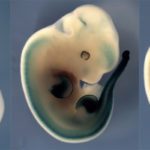Link to Pubmed [PMID] – 9826681
Proc. Natl. Acad. Sci. U.S.A. 1998 Nov;95(24):14220-5
Myogenin, one of the MyoD family of proteins, is expressed early during somitogenesis and is required for myoblast fusion in vivo. Previous studies in transgenic mice have shown that a 184-bp myogenin promoter fragment is sufficient to correctly drive expression of a beta-galactosidase transgene during embryogenesis. We show here that mutation of one of the DNA motifs present in this region, the MEF3 motif, abolished correct expression of this beta-galactosidase transgene. We have found that the proteins that bind to the MEF3 site are homeoproteins of the Six/sine oculis family. Antibodies directed specifically against Six1 or Six4 proteins reveal that each of these proteins is present in the embryo when myogenin is activated and constitutes a muscle-specific MEF3-binding activity in adult muscle nuclear extracts. Both of these proteins accumulate in the nucleus of C2C12 myogenic cells, and transient transfection experiments confirm that Six1 and Six4 are able to transactivate a reporter gene containing MEF3 sites. Altogether these results establish Six homeoproteins as a family of transcription factors controlling muscle formation through activation of one of its key regulators, myogenin.

